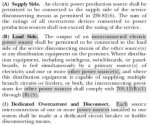1- If you have two string inverters, each tied to it's own breaker, and one can be disconnected without affecting the other, then how is that not two PV systems? Either system by itself meets the Article 100 definition.
"Photovoltaic (PV) System. The total components and
sub-system that, in combination, convert solar energy
into electric energy suitable for connection to a
utilization load."
2- They don't aggregate into a 705 'source', in my opinion, unless they share some dedicated distribution equipment that allows the entire source to be shut off at once.
3- To me this section is badly worded. I'd replace 'associated with' with 'dedicated to'.
4- Say you have two inverters that are connected in two different subpanels on a property. Both subpanels have normal loads in them. It makes no sense whatsoever to regard both inverters are a single source for purposes of subpanel busbar calculations. However if on a different property you have two inverters that are aggregated in a dedicated subpanel before being connected elsewhere, it makes sense to call that subpanel part of the source.
5- the source or system itself is a combination of multiple components, not the disconnecting means.
6- Microinverters don't.
7- You could have multiple 'PV systems' connected to one supply side connection, in my opinion.
8- You can also have multiple supply side connections on one service. See the wording of 230.40 Exception 5.
I still think this works:
705.12(A) Supply Side.
Power production equipment shall be permitted to be connected to the
supply side of the MAIN service disconnecting means as permitted in 230.82(6). The rating of
the overcurrent device or sum of OCDs protecting the power production equipment
shall not exceed the rating of the service disconnecting means or service conductors, whichever is lower.
8-
Exception No.5: One set of service-entrance conductors
connected to the supply side of the normal service disconnecting
means shall be permitted to
supply each or several
systems covered by 230.82(5) or 230.82(6). ... (5) = fire pumps, 230.82(6) = Solar photovoltaic systems
Wasn't it you that told me PV systems do *not* get supplied, so therefore aren't a service?
And what is "each or several"? How many exactly is several? :huh:
1- Either system by itself is not "the total components". And "connection" sounds singular.
2- If there is one set of PV conductors for the output of 4 inverters, there's going to be a breaker or fuses for them. That's *part of* the thing in green, and it can be the disconnect for 1 inverter or 12 inverters.
3- I'd say a Rapid Shutdown switch is dedicated to disconnecting the PV system/source.
4- I'd say the first bolded part is 2 systems, and the second is one. It's two sources both times.
5- It should say "All of the"
The total components and sub-system that, in combination
You said-
a combination of multiple components
Either system by itself
I really don't get what you are getting at.
one inverter ---> panel ---> switch ---> j-box
4 inverters ---> panel ---> switch ---> j-box
Those are both 1 system. The first has 1 source, the second has 4.
6- Yes, true. Those aren't my thing , but I do know you don't make 12 supply side connections for 12 microinverters.
7- Sure, you could have solar roof tiles on a house thru one inverter and regular panels on a garage thru another inverter, why wouldn't you combine them?
I can't see the benefit to multiple supply side connections, and that exception is just weird. I read it to say you can have a fire pump and PV on the same SECs.
supply each or several
systems covered by 230.82(5) or 230.82(6).
230.82
(5) Taps used only to supply load management devices,
circuits for standby power systems, fire pump equipment,
and fire and sprinkler alarms, if provided with
service equipment and installed in accordance with requirements
for service-entrance conductors.
(6) Solar photovoltaic systems, fuel cell systems, or interconnected
electric power production sources.



